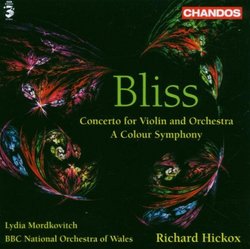| All Artists: Arthur Bliss, Richard Hickox, BBC National Orchestra of Wales Title: Bliss: Concerto for Violin and Orchestra; A Colour Symphony Members Wishing: 0 Total Copies: 0 Label: Chandos Original Release Date: 1/1/2006 Re-Release Date: 10/17/2006 Genre: Classical Styles: Chamber Music, Forms & Genres, Concertos, Historical Periods, Classical (c.1770-1830), Modern, 20th, & 21st Century, Instruments, Strings, Symphonies Number of Discs: 1 SwapaCD Credits: 1 UPC: 095115138021 |
Search - Arthur Bliss, Richard Hickox, BBC National Orchestra of Wales :: Bliss: Concerto for Violin and Orchestra; A Colour Symphony
 | Arthur Bliss, Richard Hickox, BBC National Orchestra of Wales Bliss: Concerto for Violin and Orchestra; A Colour Symphony Genre: Classical
|
Larger Image |
CD Details |
CD ReviewsBliss's Big Symphonic Concerto Thomas F. Bertonneau | Oswego, NY United States | 11/12/2006 (5 out of 5 stars) "Sir Arthur Bliss (1891 - 1975), a classicist by training as well as a composer, and a soldier who fought in World War One, enjoys such notoriety as he retains among music lovers largely on the basis of two works: "A Colour Symphony" (1922) and the music for the Alexander Korda / William Cameron Menzies production of H. G. Wells' "Things to Come" (1936). Both scores deliver a vivid and immediate musical experience, being brilliantly and even gorgeously orchestrated and richly endowed with the memorable melodies that were always a mark of their composer's art. As in the cases of some other composers (Gustav Holst is an example), the popularity of one or two of Bliss' compositions has tended to obscure the others, many of which are as rewarding as the better known ones. Bliss wrote three large-scale concertos and one shorter concerted work. The Piano Concerto came first, in 1939; the Violin Concerto followed in 1955, with the Cello Concerto finally appearing in 1971. A Concerto for Two Pianos and Orchestra, reworked from a chamber piece, belongs to the late 1920s, with a final rewriting in 1950. None of the Bliss concertos can boast much currency, which is a shame given their merits. The Piano Concerto has done best, entering the discography in 1943, with its dedicated soloist, Solomon Curzon, and the Liverpool Philharmonic under Adrian Boult. At least one stereo recording appeared in the late 1950s, and most recently Naxos has issued the work, with Peter Donohoe at keyboard and the Royal Scottish National Orchestra under avid Lloyd-Jones. The Cello Concerto was almost immediately recorded and has been re-recorded two or three times. The Violin Concerto turns out to be the most neglected member of the trio of concertos, yet it is also arguably the grandest. Its dedicatee, Alfredo Campoli, recorded it in 1956, in good monophonic high fidelity sound, with Bliss himself as conductor. Campoli's recording figured in the 1990s in the "Campoli Classics" catalogue. Now at last, fifty years later, Chandos has finally included the work in their ongoing leisurely survey of the Bliss oeuvre, with Lydia Mordkovitch as soloist and Richard Hickox leading the BBC Philharmonic, paired with "A Colour Symphony."
Bliss tried, with considerable success, to synthesize different, nearly irreconcilable aspects of Twentieth Century music. He absorbed influences from Stravinsky and "Les Six," but he also saw himself as working in the Elgar-Rachmaninov Late-Romantic vein. These antithetical impulses give "A Colour Symphony" much of its dazzling power. In the concertos, however, the Late-Romantic strain predominates over the modernist strain, and in none more so than in the Violin Concerto. A big work lasting more than forty minutes in performance, it consists of two fast movements followed by a movement in moderate tempi spiced up by Scherzando episodes on a recurring Gypsy theme. The inner movement is the shortest, with the outer movements more or less balancing each other. The main theme of the First Movement is a cantabile tune that sticks in the mind. The development is symphonic in all three movements, while the orchestration is rich, blending the instrumental choirs in what one might describe as "subdued Technicolor." The Second Movement gives the scherzo of Walton's Violin Concerto a run for the money and brings a dash of astringency to the score. In the Finale, which begins with a minor-key hymn-like tune reminiscent of the "tragic" music from the "Things to Come" film score, Bliss builds a complex structure suggesting an extra-musical program. This is not to say that the music lacks conviction musically. Far from it. Lydia Mordkovitch brings a Campoli-like muscular tone to the solo part. The sound on the new Chandos disc of course excels that on the 1956 recording. It would be nice were Campoli's version to resurface. Meanwhile, Mordkovitch is the only game in town for this particular work. It does full justice to this complex, neo-Romantic work. Hickox's reading of "A Colour Symphony" pits itself against a good deal of fine competition, including a worthy monophonic version from the mid-1950s led by the composer himself. I heard much detail in this new recording that I had missed in earlier ones. Hickox brings a beautiful riparian stillness to the slow movement. To the concluding fugal movement he brings the full measure of fiery power, with the tymapnist really banging out a thunderstorm against the augmentation of the theme in the brass in the last measures." |

 Track Listings (7) - Disc #1
Track Listings (7) - Disc #1